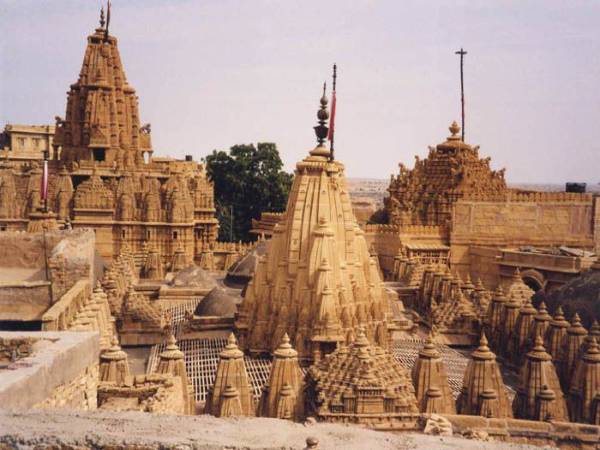
desert sites in Rajasthan
January 4, 2023Jain temples in Jaisalmer
Once, centuries back, Jain traders were the most prosperous people in Jaisalmer. They were rich, wealthy, and deeply religious people, who built temples all around the desert city of Jaisalmer.
Today, if you go to visit Jaisalmer, you must see these Jain temples. All are constructed out of yellow sandstone, and they look beautiful at the time of the setting sun and in the early morning sunrise.
What is striking about these temples is their magnificent architecture and intricate carvings.
We are about to explore these splendid Jain temples, and they are not just religious places for Jains, but fascinating tourist sites of Jaisalmer.
1. Temples inside Jaisalmer Fort
We will begin by the No.1 tourist site of Jaisalmer, the Golden Fort of Jaisalmer.
In this fort, you will find 7 (seven) Jain temples, and they all are connected with each other through gates and corridors. All are devoted to Jain Tirthankaras (spiritual teachers).
These Jain temples are visited by devotees, & Jain priests manage the daily operations of these temples even today. They will even give interesting insights into the history of these temples.
You have to wear decent clothes before entering these temples. And don’t forget to offer your prayers at these temples, and you will receive blessings from the priests. Let us see which these temples are:-
1.1 Chandraprabhu Jain Temple
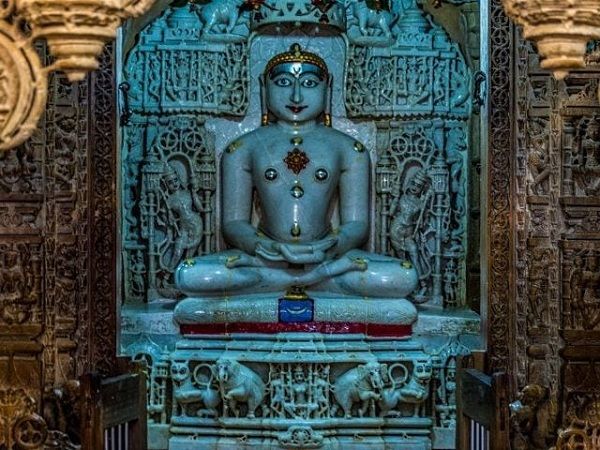
Chandraprabhu Jain Temple is inside the Jaisalmer Fort & was made in the year 1509 AD and is dedicated to the 8th (eighth) Jain Tirthankara Chandraprabhu.
The Rajput architecture of this temple can be seen in its elaborately carved mandapa and pillars & the dome from the inside of this temple is finely carved with delicate sculptures.
There are walkways through which you can go to the upper levels of this temple, and explore the carvings from a close distance.
The carved idol of Chandraprabhu is made of pure marble, and there are innumerable sculptures of apsaras (nymphs), elephants, and other characters from Jain mythology carved in the pillars of the temple.
Beautiful corridors will lead you to the inner parts of this temple, and there are courtyards with intricately designed stonework.
1.2 Rishabhdev Jain Temple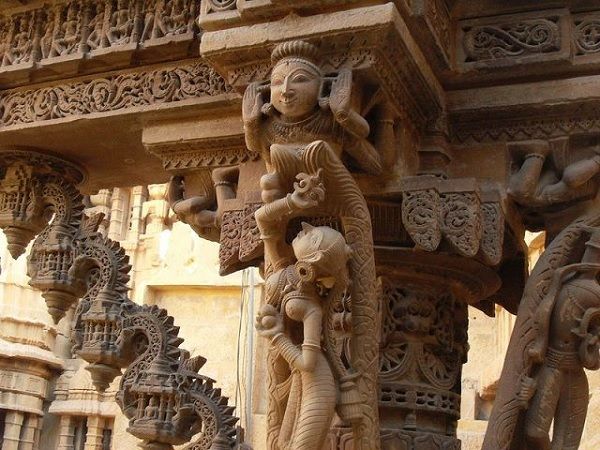
Rishabhdev was the very first of the Jain Tirthankaras, and this temple in Jaisalmer Fort is dedicated to him.
On the outside, the temple is a striking monument, with a tall shikhara and impressive carved pillars.
This temple is also inside the Jaisalmer Fort and as soon as you enter this temple, a few steps will lead you to the inner sanctum, where there are huge pillars carved with extremely delicate sculptures.
The marble idol of Rishabhdev is surrounded by the most amazing carvings on a marble stone.
There are a lot of other carved idols of Jain Tirthankaras. There are corridors through which you can walk and explore the other parts of this temple.
1.3 Parsvanatha Jain Temple
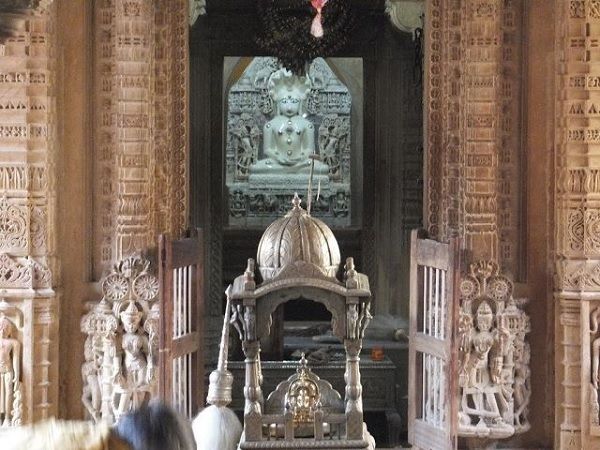
Another Jain temple inside Jaisalmer Fort is Parsvanatha Jain Temple. Parsvanatha was the 23rd (twenty-third) Jain Tirthankara, and this temple is dedicated to him.
The arched torans between the pillars, with their incredible architectural beauty, will mesmerize you once you enter this temple & the symmetrical designs of the pillars, and the ornate sculptures on them are breath-taking thing sights to see in this temple.
But its mandapa or the inner dome will amaze you even more with its delicate craftsmanship.
Walk through the corridors between the pillars and you go to the different parts of this temple and observe every minute detail of carvings that are everywhere in the temple.
The marble sculpted idol of Parsvanatha with its hooded serpent is an eye-catching sight.
1.4 Shitalnath Jain Temple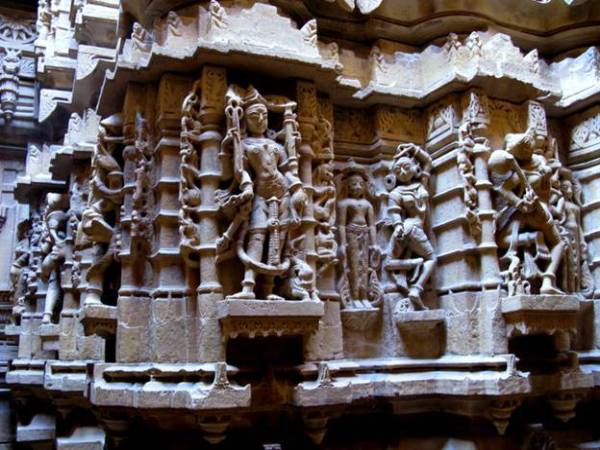
Shitalnath was the 10 (tenth) Jain Tirthankara and this temple has a beautiful idol of Shitalnath.
This temple looks small when compared to the other temples in Jaisalmer Fort, but it has the same delicately carved pillars, with sculptures carved out of stone.
The idol is made of eight precious metals. You will temple architecture similar to the Dilwara temples near Mount Abu.
1.5 Shantinath Jain Temple
Shantinath Jain Temple is also inside Jaisalmer Fort, and it was built in the year 1536.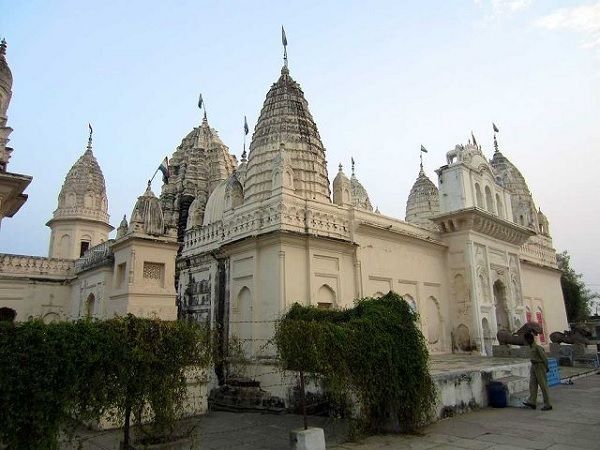
Shantinath was the 16th (sixteenth) Jain Tirthankara, and his idol is beautifully carved out of marble and you can find it in the inner sanctum of this temple.
Like in other temples, here too, are delicate sculptures of elephants and other mythical creatures, male and female dancers and apsaras, and intricately carved out pillars.
You can reach this temple through Parsvanatha or Kunthunatha Jain temples & you will also find idols of all the twenty-four Jain Tirthankaras inside this temple.
1.6 Kunthunatha Jain Temple
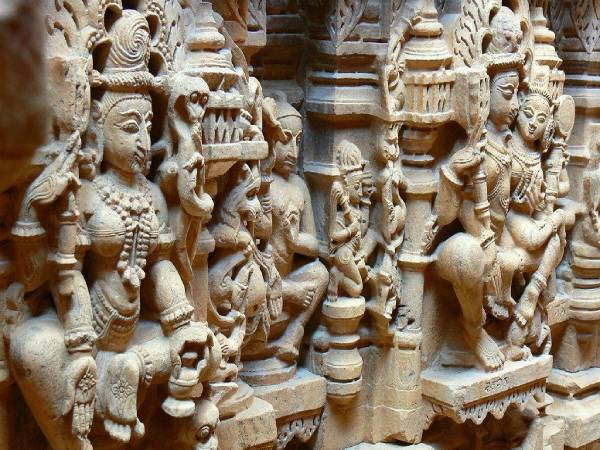
Kunthunatha was the 17th (seventeenth) Jain Tirthankara, and this temple inside Jaisalmer Fort is dedicated to him.
The temple is majestic in structure, and the beautifully carved marble idol of Kunthunatha is also quite soothing to look at.
You will find interesting carvings that depict stories from Jain mythology, and finely sculpted idols of male and female dancers, apsaras, and musicians in dancing poses and meditating poses.
There are sculptures of elephants and carved pillars inside this temple.
1.7 Sambhavnath Jain Temple
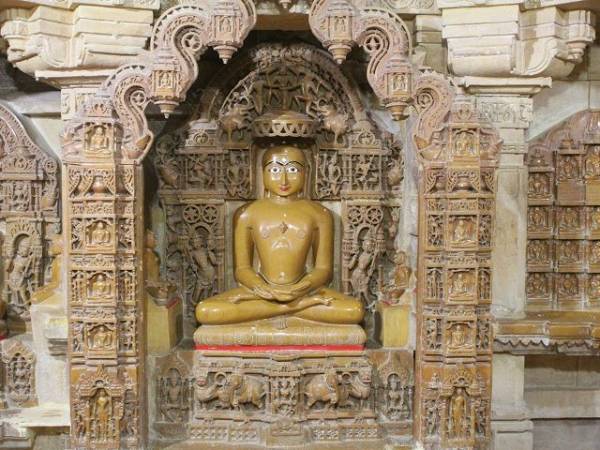
The third (3rd) Jain Tirthankara, Sambhavnath is the main deity of this Jain temple inside Jaisalmer Golden Fort.
The intricately carved pillars & the main idol of Sambhavnath Jain Temple are finely sculpted, & the fine Torana designs connecting the pillars are also breathtaking.
In the basement of this temple, there is an ancient library that has many original manuscripts of the Jain religion dating back to the 11th century. You will also find illustrations, charts, books, and other rare artifacts.
If you are interested in religious books, this library will surely be of immense interest to you.
While Jaisalmer Fort itself has some fabulous Jain temples in Jaisalmer, you can find out more beautiful ones if you go outskirts of Jaisalmer city.
Here you will find temples such as the ones described below:
2.1 Lodurva Jain Temple
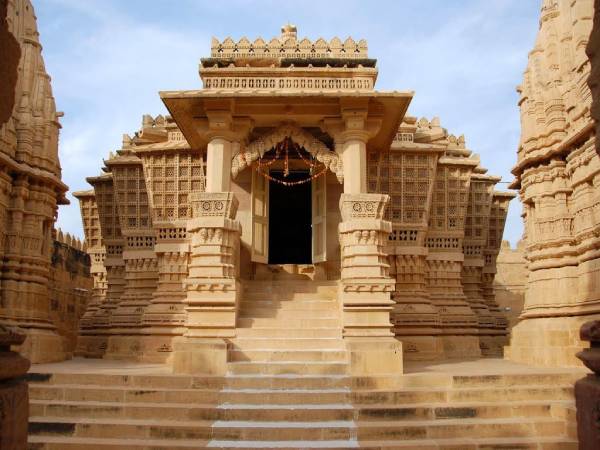
Coming to Lodurva, 20 km from Jaisalmer, you will find a magnificent Jain temple, which is dedicated to the 23rd Jain Tirthankara, Parsvanatha.
The temple was ransacked and destroyed many times in ancient times by the forces of Mahmud of Ghazni and Muhammad of Ghori. Eventually, Bhatti Rajputs shifted their capital to Jaisalmer, and Lodurva was deserted and its temple remained the sole survivor, illustrating the glorious past of Lodurva.
The temple, built of yellow sandstone, has a jaw-dropping architectural beauty that will mesmerize tourists and visitors.
Intricately carved pillars with finely chiseled sculptures and gorgeous arched gateways or Torana between these pillars are the first of the many striking features that will greet you in this temple.
There is a Kalpavriksha, or Tree of Life, in the center of this temple with amazing latticework or jaali designs and corridors where you can walk and see the carved walls and outer structures of this temple. The interiors are magnificent as well, and the dome of the temple has the most astonishing carvings on stone.
The temple, though ruined, is in superb condition, even after so many centuries of neglect, and has stood the hostile desert conditions of the Thar Desert.
2.2 Amar Sagar Jain Temple
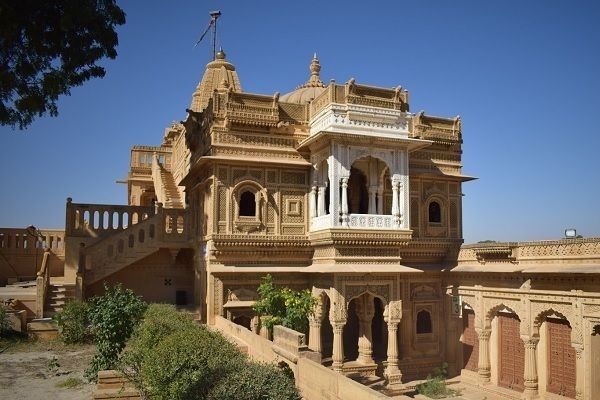
Amar Sagar is a man-made reservoir near Jaisalmer, and on the shores of this reservoir, there is a spectacular Jain temple. A rich merchant, Patwa Bafna Himmat Ram built this temple in the year 1928, and the temple is dedicated to Parsvanatha, a Jain Tirthankara.
Amar Sagar Jain Temple is also known as Adeswar Nath Jain temple and is one with amazing architectural beauty.
The walls, ceilings, and pillars, all are carved with finely detailed sculptures & the lake-side surroundings of this temple, the tranquil environment, and a sacred temple space, all create a fascinating charm making you linger all the more in this temple.
There are other smaller temples in the vicinity, and their intricate lattice work is worth noticing.
3. More Jain temples in Rajasthan
Not only in Jaisalmer, if you want to visit Jain temples in Rajasthan, but you will also find countless temples all over this royal state of Rajasthan.
They are even more beautiful, even more, spectacular than the ones found in Jaisalmer.
Let’s see which are the major Jain temples that you can see in other cities of Rajasthan:
3.1 Ranakpur Jain Temples, Pali
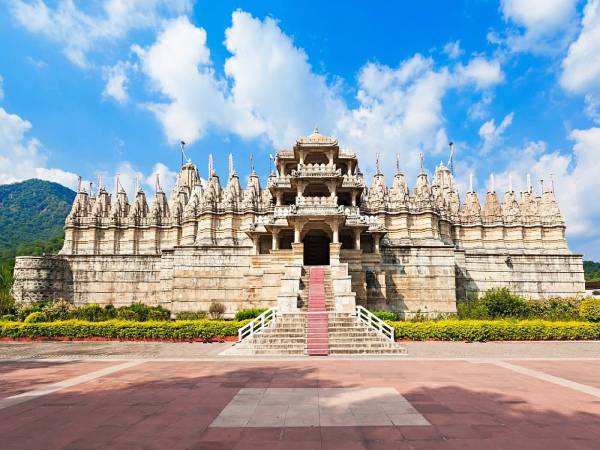
Among the most visually spectacular Jain temples in Rajasthan is Ranakpur Temple. This temple was built back in the 15th century and is named after Rana Kumbha, the illustrious Rajput king of Mewad.
A wealthy trader once had a dream in which he was directed to build a temple. Following this divine dream, he started to construct this temple, and today it is not only a major tourist attraction of Rajasthan but among the great archaeological treasures that the ancient kings of Rajasthan left behind as heritage monuments.
The temple is made of marble stone, and its finely detailed carvings and innumerable sculptures show the finesse of Rajasthani craftsmen and artisans.
The main deity is Adinatha, the first Tirthankara of the Jain religion. It’s a huge temple, and you will find many other temples in this complex beside the main temple.
Everything from the mandapa (compound), shikhara (tall spire), murti (shrines), and domes, to cupolas, windows, and prayer halls, are carved with highly detailed carvings.
The 1444 pillars, though, are a stunning visual treat, as you will find them everywhere, with the most spectacular sculptures carved on them, and intricately designed patterns. The pillars are so precisely carved, that no two pillars have the same carvings and designs.
Ranakpur Jain Temple is closer to Udaipur, and you can go on a day trip from Udaipur to visit them together with Kumbhalgarh Fort.
3.2 Dilwara Temples, Mount Abu
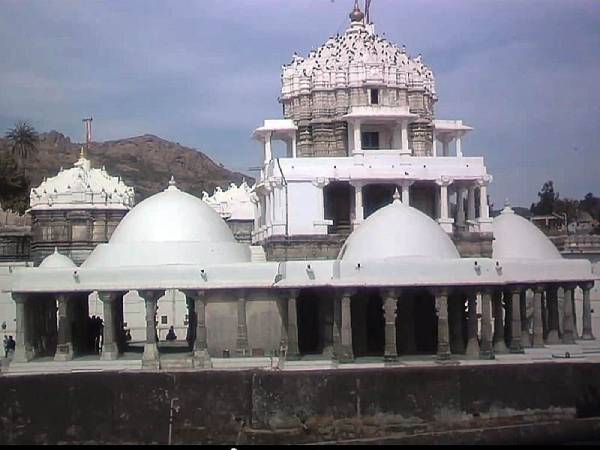
Being close to Mount Abu, Dilwara Temples are a hot favorite tourist destination for tourists traveling to this one and only hill station of Rajasthan.
Dilwara Temples were built between the 11th & 13th centuries and are the most magnificent of all the Jain temples found in the world, and certainly in Rajasthan.
There are five temples in this temple complex and they are devoted to the Jain Tirthankaras like Adinath, Parsvanath, Rishabhdev, Neminath, and Mahaveer Swami.
Their construction is the most amazing you will see in any marble temple, and the finesse with which the sculptures are carved, and the geometrical patterns with which the pillars are constructed, will leave you wonderstruck at the architectural superiority of temple architects of those times.
Intricate carvings are found everywhere in this temple, and the details are so fine and so delicately carved out of marble stone, that it will arrest you with its elegance.
Walk in the corridors of this temple, and simply admire the carved pillars, ceilings, sculptures, and in temple halls.
Even the gates are beautiful, and the Torana between the pillars is carved with precision and delicate artistic details.
3.3 Shri Mahaveer Ji temple, Karauli
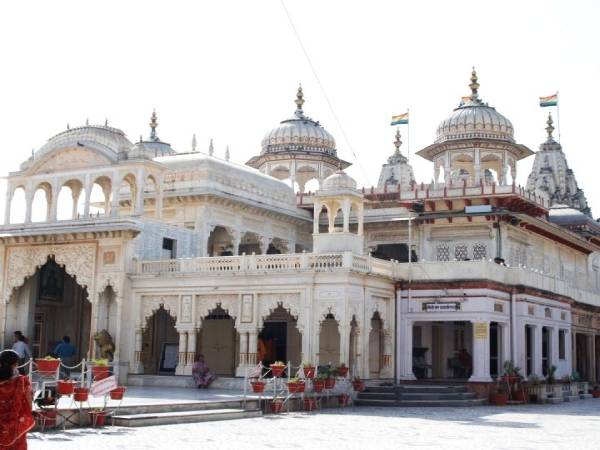
Shri Mahaveer Ji temple is among the most visited, and sacred Jain pilgrimage sites in Rajasthan. It was constructed near a river in the Karauli district in Rajasthan.
The idol of Lord Mahaveer is said to have been found during an excavation, and is said to have miraculous properties, and fulfills the wishes of a million devotees, who come here every year to have their prayers answered.
The shikhara or pinnacles of this temple are very attractive, and on the exterior walls, there are scenes depicting chapters from Jain mythology etched and carved out of stone.
In the garbha griha, or the main chamber where the chief idol is to be found, you will find the beautifully carved-out sculpture of Bhagwan Mahaveer in Padmasana i.e. sitting posture.
There are other idols of Jain Tirthankaras, besides the main idol, and all are as beautiful as that of the chief idol.
There are paintings and carvings on the walls, and guest houses all around the temple for devotees to stay.
3.4 Tijara Jain Temple, Alwar
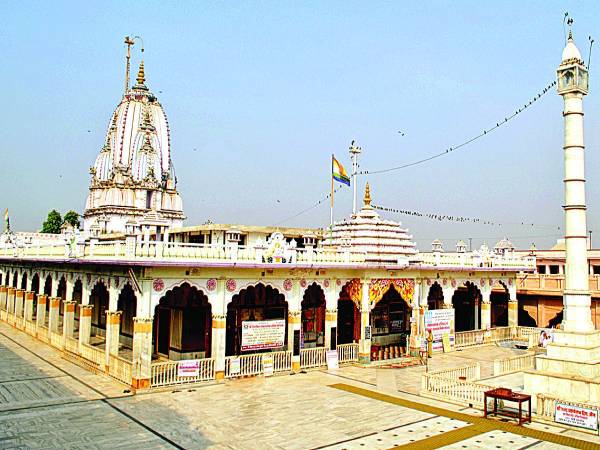
Alwar is a major tourist destination in Rajasthan, and close to Alwar is the spectacular Tijara Jain Temple. It is a major pilgrimage center for Jain devotees, and the temple is said to be a place of miracles.
Chandraprabha was the eighth Tirthankara of the Jain religion, and this temple is dedicated to him.
In the temple, the idol of Chandraprabha is seated in padmasana pose, and the white marble idol is said to be so miraculous, that a mere darshan of him can drive off evil spirits that may be haunting a person.
There’s a black idol too, and it’s also as beautiful as the white one.
The superb architecture of this temple can be seen in its outer structure, and the prominent shikhara or temple spire can be seen against the blue sky, superbly carved out of stone.
All around this temple, there are innumerable pillars and in the interior, there is a prayer hall with beautiful paintings adorning the walls.
You will see scenes from Jain mythology portrayed in these paintings.
There are other temples too, besides the main temple, and they too are devoted to Jain Tirthankaras.
3.5 Mahavirswami Swetamber Jain Temple, Osian
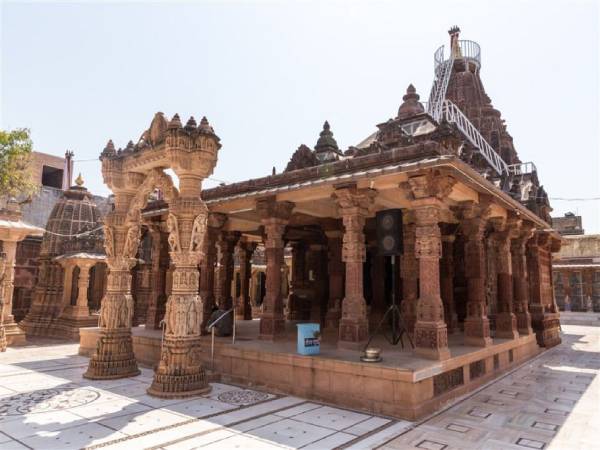
Osian is a small village near Jodhpur, and it’s famous for its sand dunes and remarkable temples.
The Jain temple found here in Osian is dedicated to Bhagwan Mahaveer, and it’s called Mahavirswami Swetambar Jain Temple.
This temple is the oldest surviving Jain temple in India and was built in 783 AD.
Even though it’s very old, the carvings you will see in the mandapa, prayer halls, ceilings, and walls are far superior in their designs and sculptures.
There is the main idol of Mahaveer, and also those of yaksha and yakshas (male and female celestial beings), and other Tirthankaras.
The temple is an architectural marvel in itself, and among the most interesting tourist sites in Rajasthan.
![Suman_Logo[1]](https://www.thesumantours.in/wp-content/uploads/2023/01/Suman_Logo1.png)

